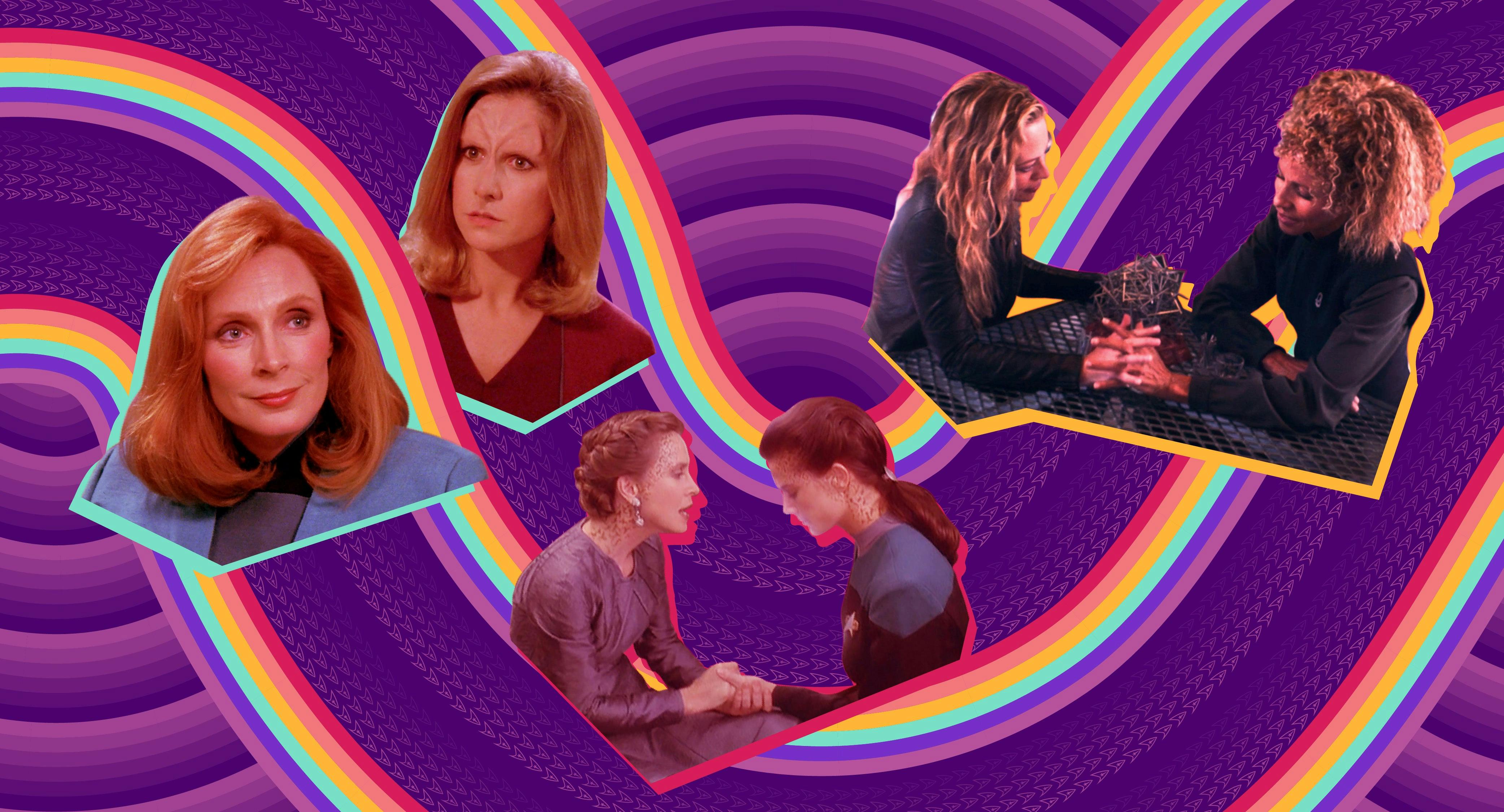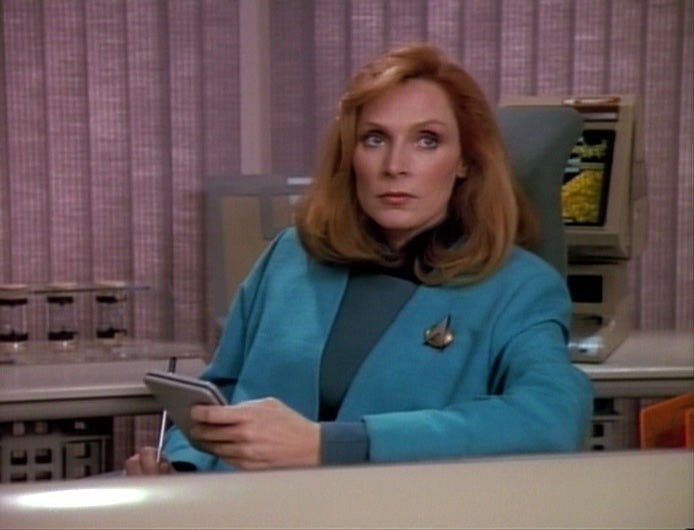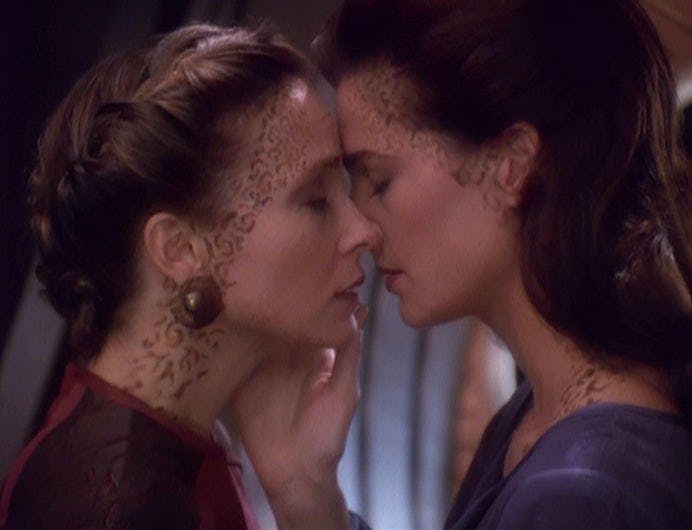Published Mar 8, 2022
Growing Up Female and Queer with Star Trek
Fans track how the relationships between LGBTQ women have evolved over the course of Star Trek's history

StarTrek.com
Growing up female, queer, and an avid Star Trek fan was could be a bit of a mixed bag at times. For such a groundbreaking show that challenged itself and its viewers to imagine a future free from so many of the evils of our own time, it showed an uncharacteristic timidity when it came to LGBTQ+ representation. For those whose formative years were spent watching The Next Generation, Deep Space Nine, and Voyager, Star Trek’s will-they-won’t-they treatment of romance between female characters could at once lead to moments of self-realization and affirmation while at the same time sending confusing messages about the legitimacy and social acceptability of same sex attraction.
Queer fans first felt a glimmer of hope during the TNG episode “The Host” (originally aired in 1991) when Dr. Crusher begins a whirlwind romance with the Trill mediator Odan, who at the time is in a male host body. However, when the host body is mortally injured, a female is sent as a replacement. Presented with the opportunity to continue their romance, regardless of Odan’s change in gender, Crusher demurs. The implied assumption was that Dr. Crusher would have no interest in continuing her relationship with Odan once he is no longer a man. This is in striking contrast to the fact that she was prepared to be intimate with Odan while he was temporarily inhabiting the body of her close friend, Riker. As an inadequate host, Riker was essentially a glorified marionette, Yet Dr. Crusher seemed to struggle very little with that unusual situation.
The episode adds insult to injury as Dr. Crusher implies that the human race is not yet capable of understanding relationships that transcend heterosexual norms. She says to Odan, “Perhaps it is a human failing, but we are not accustomed to these kinds of changes.” Of course, no one would hold it against Crusher if she just wasn’t physically attracted to women. However, when she says, “Perhaps, someday, our ability to love won’t be so limited,” it gives the strong impression that she means all of humanity can only enjoy a romantic relationship with someone of the opposite sex which is, obviously, patently untrue. Crusher didn’t intend to fall in love with a woman, but it’s a crazy universe out there and these kinds of narrative twists are a chance to confront society’s shortcomings. Sadly, instead, the show chose to shy away from any meaningful discourse and double down on reinforcing the heteronormative status quo.

StarTrek.com
A handful of years later, Deep Space Nine introduced the Star Trek universe to the fluidity of sexuality and love in the episode “Rejoined.” As before, the Trill provided fertile ground for the exploration of whether romantic love can endure when one party changes gender. Once again, this seemed like an ideal opportunity for the show to introduce a same sex relationship. In this episode, a team of Trill scientists visit the station. Lenara Kahn, the lead scientist, is a joined Trill who, in a previous host, was married to Torias Dax. The two women discover that the love from their former lives continues to bond them together and makes it impossible to stay apart. They even find that they are more compatible in their current hosts than those of the past. The tension between them culminates in a passionate kiss, only the fifth lesbian kiss in an American series. By framing Jadzia and Lenara’s feelings for one another as taboo, Star Trek once again missed the chance at meaningful LGBTQ+ representation.
In “Rejoined,” the viewer can find a multi-layered commentary on the existence and acceptability of LGBTQ+ individuals in Star Trek. The initial message to the viewer was that same sex love exists, but it was equal parts validated and diminished through this episode. It was validated through the moments of intimate connection that the audience is privy to. Reminiscing about the past, sharing moments of pride in each other’s work, and the glances Jadzia and Lenara share give a window into their feelings. The depiction of their relationship was incredibly welcome to the queer viewer. The genuine connection between the women was undeniable. However, their affection for one another, while it might be genuine and valid, is neither accepted nor acceptable. Throughout the episode, Trill law is used as a means to proscribe their love. None of the men around them hesitate to interject themselves with authority and righteousness, seeing it as their duty as Trill to police the forbidden feelings forming between the two women.In the real world, religion often plays a similar role, upholding that while attraction to the same sex may not be a sin, acting on that attraction absolutely is. This correlation, as made on TNG, did not feel intentional, per se, but the negative impact of these kinds of messages has rippled through the LGBTQ+ community for years.

StarTrek.com
LGBTQ+ fans have waited decades for any representation. Many hoped that Star Trek would step out in front of cultural trends and lead the way forward. Fortunately, the future of Star Trek looks brighter and holds less boundaries than its past. Recently, fans of Seven of Nine were elated to see her character reappear in the series Picard. In the final episode of the first season, "Et in Arcadia Ego", after years of speculation from fans and behind-the scenes politics, viewers got what they had been waiting for. A simple, elegant moment in which Seven and Raffi clasp hands while playing kal-toh. No grand gestures needed, no ‘coming out’ episode, no scenes of hand-wringing anxiety from key characters. Just a natural moment of love between two characters who just happen to share a gender. Fifty-five years and eight series after Star Trek first aired in 1965, queer female viewers finally saw that in Gene Roddenberry’s utopian future two women were free to fall in love.
VIDEO ESSAY: Growing Up Female and Queer with Star Trek
In this one scene, young queer viewers today get something from Star Trek that was missing for the previous generation of fans. An acknowledgement that queer women do exist; to paraphrase Dr Crusher, in the Star Trek universe, our ability to portray love is at long last no longer so limited.
Now living in London with her wife and pug, but originally from New Zealand, Bernice Watson (she/her) grew up with Star Trek and has considered many of its strong female characters as role models throughout her life. She has a lifelong love for science fiction and fantasy as well as feminism, LGBTQ+ issues, and contemporary culture!
Meredith Lee’s (she/her) science fiction fandom was born from years of watching Star Trek with her family. She is always excited to engage in conversations on the quality of female representation in the media as well as how that representation intersects with minority groups. She lives in the US with her partner and kids.
Star Trek: Picard streams exclusively on Paramount+ in the U.S. and is distributed concurrently by ViacomCBS Global Distribution Group on Amazon Prime Video in more than 200 countries and territories. In Canada, it airs on Bell Media’s CTV Sci-Fi Channel and streams on Crave.

